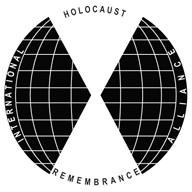“Our commitment must be to remember the victims who perished, respect the survivors still with us, and reaffirm humanity's common aspiration for mutual understanding and justice.”
-- Declaration of the Stockholm International Forum on the Holocaust
 INTERNATIONAL HOLOCAUST REMEMBRANCE ALLIANCE
INTERNATIONAL HOLOCAUST REMEMBRANCE ALLIANCE
“Our commitment must be to remember the victims who perished, respect the survivors still with us, and reaffirm humanity's common aspiration for mutual understanding and justice.”
-- Declaration of the Stockholm International Forum on the Holocaust
On 26 November 2017, the International Holocaust Remembrance Alliance (IHRA) successfully concluded a conference in Bern, Switzerland, on the murder of people with disabilities and the Holocaust together with the Paedagogische Hochschule Bern and the Federal Department of Foreign Affairs of Switzerland.
“Whereas Holocaust victims are commemorated by name, the situation for commemorating Nazi victims with mental and physical disabilities remains fragmented,” stated Paul Weindling, professor in the history of medicine at Oxford Brookes University, during the conference.
While much research has been carried out on the murder of people with disabilities during Nazi operations in the German Reich, recent research also focuses on murders in occupied eastern and western Europe. The IHRA conference aimed to bring this new research together in one place to provide a fuller picture of the murder of people with disabilities and to explore the continuities of methods and perpetrators with the Holocaust.
The conference was opened by IHRA delegate and conference organizer Brigitte Bailer who stressed: “The mass murder of people with disabilities was carried out both in the shadow of the war as well as alongside the crimes of the Holocaust.” Brigitte Bailer also stressed the unique structure of the IHRA – composed as it is of both experts and governmental representatives – as crucial in bringing together researchers, representatives of memorial sites and governmental representatives, enabling an exchange of ideas and impressions from a variety of perspectives.
Read Brigitte Bailer's address
The conference focused on two Nazi operations to kill people with disabilities or illnesses: the “Aktion T4", the Nazi Euthanasia program, and the Aktion “14 f 13”, the murder of concentration camp inmates categorized as sick and no longer able to work, who were killed in the same extermination institutions used in the “Aktion T4” (“T4” refers to Tiergartenstrasse 4, the address of the headquarter of the Gemeinnützige Stiftung für Heil- und Anstaltspflege ("Charitable Foundation for Curative and Institutional Care").
In his opening remarks Ambassador Benno Bättig, IHRA Chair, reflected on how studying the crimes of the Nazis often also make us think of our contemporary societies:
“Today, as we discuss this rarely spoken of aspect of the mass murder of people with disabilities, let us be reminded and let us never forget states’ obligations to protect their citizens. Let us reaffirm that every human being has the inherent right to life.”
Consult the conference programme and speaker abstracts
The conference began with a panel on the ideology of eugenics. Regula Argast (Pädagogische Hochschule Bern) gave an overview of Swiss eugenics and its implications for Nazi racial hygiene. Paul Weindling (Oxford Brookes University) spoke of the need to sensitively and accurately name people with disabilities murdered by the Nazis, and underlined the tendency not to publish the names or medical histories of people with disabilities who were murdered.
In the second panel, the focus was on Western Europe and historian Cecilie aan de Stegge presented new data on the mortality rates in Dutch psychiatric institutions 1940-1945, showing a vastly higher mortality rate for patients in psychiatric institutions due to starvation, than could be seen within the general population.
The third panel turned the focus to Central and Eastern Europe, where Michal Simunek (Charles University, Prague) opened the panel by outlining how "Aktion T4" was carried out in Bohemia and Moravia between1939-1941. Filip Marcinowski (Warsaw Medical University) turned his attention to the extermination of people with mental illnesses in occupied Poland and Björn Felder (Georg-August University Göttingen) focused on the mass murder of patients in the Baltic states between 1941- 1944.
The fourth panel traced the continuities and comparisons between the murder of people with disabilities and the Holocaust. Sara Berger (Fondazione Museo della Shoah) presented on the “Aktion T4” staff and their role in the “Aktion Reinhardt” extermination camps. The final presenter was Professor Yehuda Bauer, IHRA Honorary Chairman, who spoke on the interaction between the murder of people with disabilities and the Holocaust.
Watch Yehuda Bauer's address on our Facebook page
The conference culminated in a roundtable on education about the mass murder of people with disabilities and Holocaust, exploring similarities and possible synergies. Participants in the roundtable were Jan Erik Schulte (Gedenkstätte Hadamar, Germany), Florian Schwanninger (Hartheim Memorial, Austria), Thomas Lutz (Topographie des Terrors, IHRA), Otto Rühl (Danish Institute for International Studies, IHRA), David Silberklang (Yad Vashem, IHRA).
The panels were moderated by the following IHRA delegates: Karel Berkhoff (Delegation of the Netherlands), Juliane Wetzel (Delegation of Germany), Dominique Trimbur (Delegation of France) and Robert Williams (Delegation of the United States).
The conference proceedings will be compiled in a publication which is to be published in March 2019.
The IHRA unites governments and experts to strengthen, advance and promote Holocaust education, remembrance and research worldwide, and to uphold the commitments of the 2000 Stockholm Declaration.
Image: Pirna-Sonnenstein sanatorium, Pirna, Germany. In 1940 and 1941 the National Socialists murdered 13,720 people with disabilities in the former Pirna-Sonnenstein sanatorium. Over a thousand prisoners from National Socialist concentration camps also died at this site in the summer of 1941.